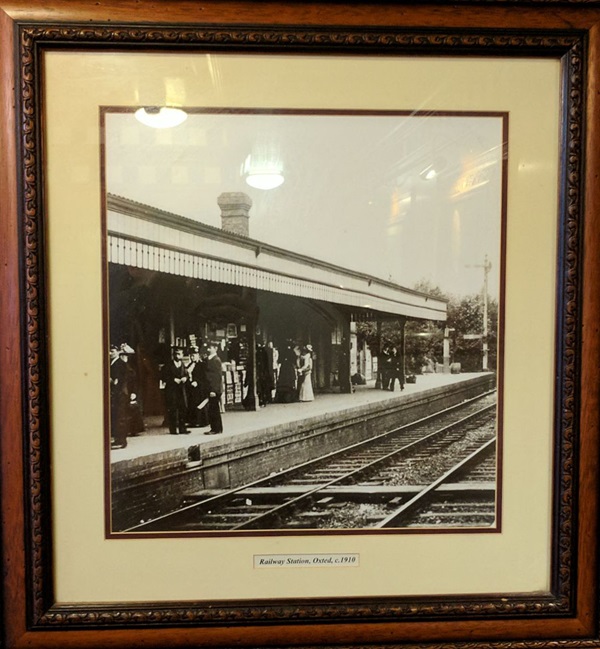Pub history
The Oxted Inn
Named after the town it is in, this pub stands on the site of extensive railway sidings. The many clocks above the bar indicate the time in various cities around the world, a reference to Oxted’s exact location on the Greenwich Meridian.

Named after the town it is in, this pub stands on the site of extensive railway sidings. The many clocks above the bar indicate the time in various cities around the world, a reference to Oxted’s exact location on the Greenwich Meridian.
Text about The Oxted Inn
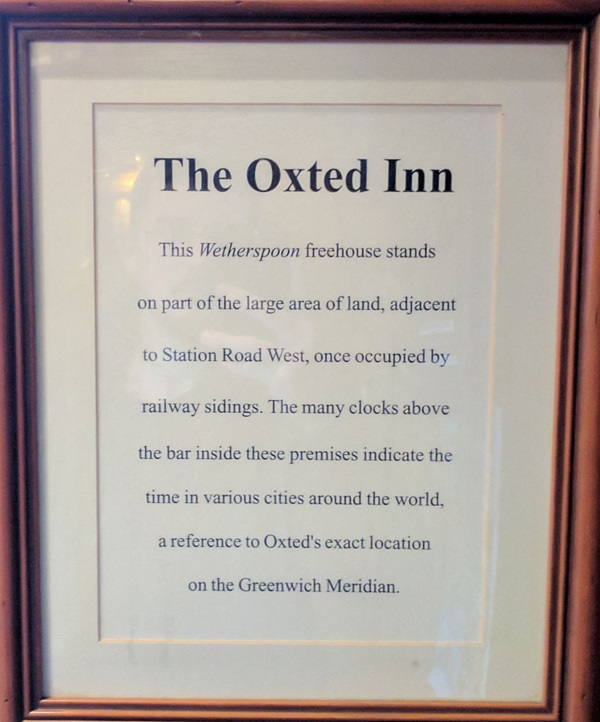
The text reads: This Wetherspoon free house stands on part of the large area of land adjacent to Station Road West, once occupied by railway sidings. The many clocks above the bar inside these premises indicate the time in various cities around the world, a reference to Oxted’s exact location of the Greenwich Meridian.
A print and text about Barn Theatre
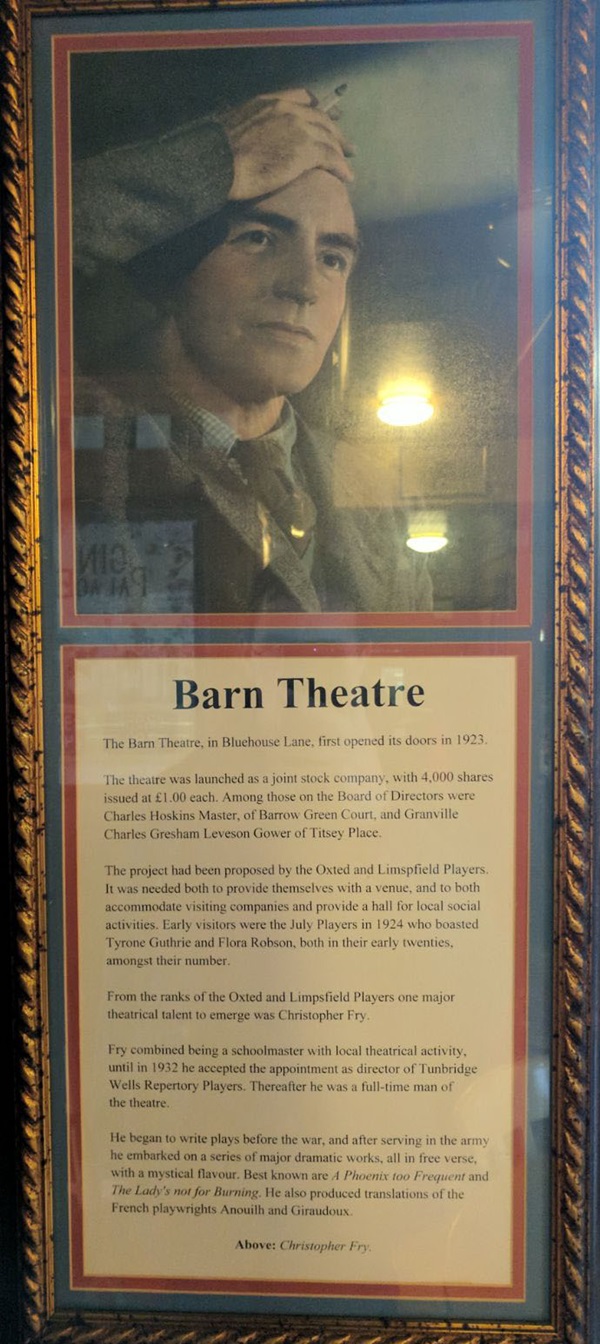
The text reads: The Barn Theatre, in Bluehouse Lane, first opened its doors in 1923.
The theatre was launched as a joint stock company, with 4,000 shares issued at £1.00 each. Among those on the board of directors were Charles Hoskins Master, of Barrow Green Court, and Granville Charles Gresham Leveson Gower of Titsey Place.
The project had been proposed by the Oxted and Limpsfield Players. It was needed both to provide themselves with a venue and to both accommodate visiting companies and provide a hall for local social activities. Early visitors were the July Players in 1924, who boasted Tyrone Guthrie and Flora Robson, both in their early twenties, amongst their number.
From the ranks of the Oxted and Limpsfield Players, one major theatrical talent to emerge was Christopher Fry.
Fry combined being a schoolmaster with local theatrical activity, until in 1932 he accepted the appointment as director of Tunbridge Wells Repertory Players. Thereafter, he was a full-time man of the theatre.
He began to write plays before the war, and after serving in the army he embarked on a series of major dramatic works, all in free verse, with a mystical flavour. Best known are A Phoenix too Frequent and The Lady’s Not for Burning. He also produced translations of the French playwrights Anouilh and Giraudoux.
Above: Christopher Fry
Prints and text about Joseph Firbank and the railway

The text reads: Firbanks
Joseph Firbank was born in a Durham miners’ cottage in 1819 and started work in the pits aged seven. In 1837, he started railway work in the Bishop Auckland district. By educating himself at night school, and learning all he could by day of mining, railways and managing labour, he was able to bid for his first construction contract in 1841.
Honesty, the ability to complete work on time, and commercial sense enabled Firbank to survive and prosper. By the 1860s, he was working in this area for the LBSCR. He was one of the better Victorian employers, paying his navvies five times the wage of an agricultural labourer. In return, he demanded hard work and keeping to deadlines.
Thomas, the eldest of eight children, took over running the business after Joseph Firbank had ‘died in harness’ in 1886. Thomas received a knighthood in 1902 but soon after suffered a decline in his health and his business. Nevertheless, Firbank’s had proved one of the longest lived of all railway contracting firms.
Above: DI 0-4-2T auto train near Hurst Green
The Oxted Line
In 1865, the Surrey and Sussex Junction Railway, running from Croydon to Oxted, to join Tunbridge Wells–Uckfield line, received an Act of Parliament. One of the first items of construction was the 2,261-yard Oxted tunnel (between Woldingham and Oxted).
However, the S&SR ran into trouble. Navvies rioted when the contractor Joseph Firbank imported Belgian labour. The lines’ backers, the London, Brighton and South Coast Railway (LBSCR) lost interest, and the powers given by the Act lapsed. All work ceased. Only a tunnel up in the wood above Oxted remained.
It wasn’t until 1878 that an Act was passed for a Croydon Oxted and East Grinstead Railway, to be jointly owned by the LBSCR and the SER (South Eastern Railway). This line was opened on 10 March 1884. A branch line, the Oxted Limeworks Railway, was opened in 1886. The narrow-gauge tracks were removed in 1969, although carryings had ceased around 1939.
Above: Crossing the A25, near Oxted
A painting of a John Harrison timepiece
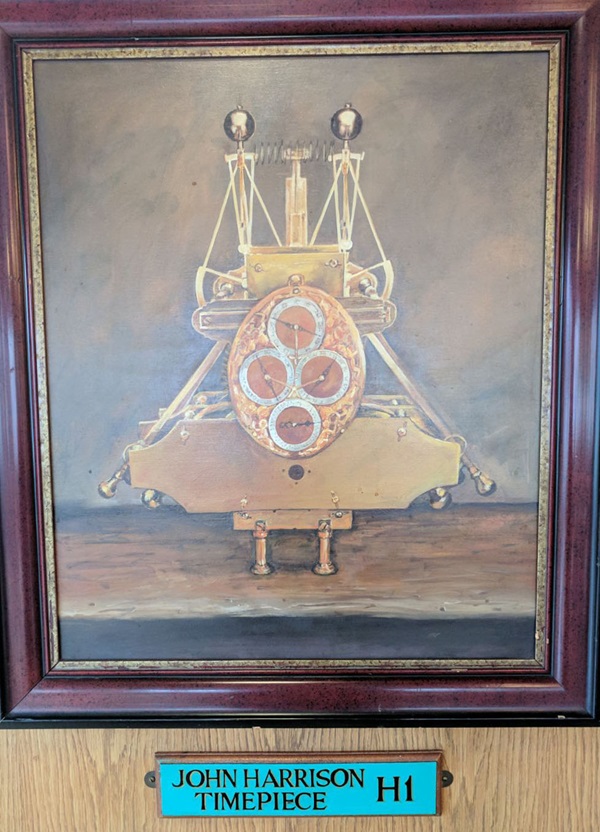
A photograph of Station Road West, Oxted, c1910
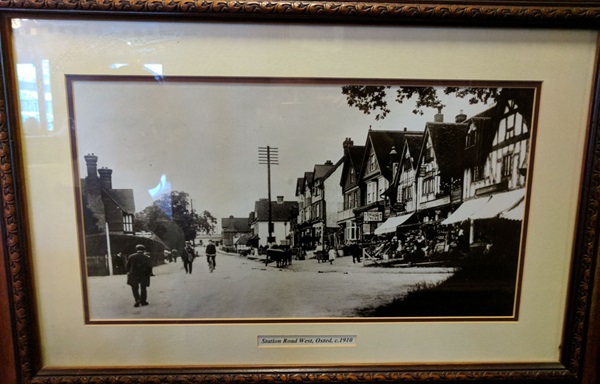
A photograph of the railway station, Oxted, 1910
